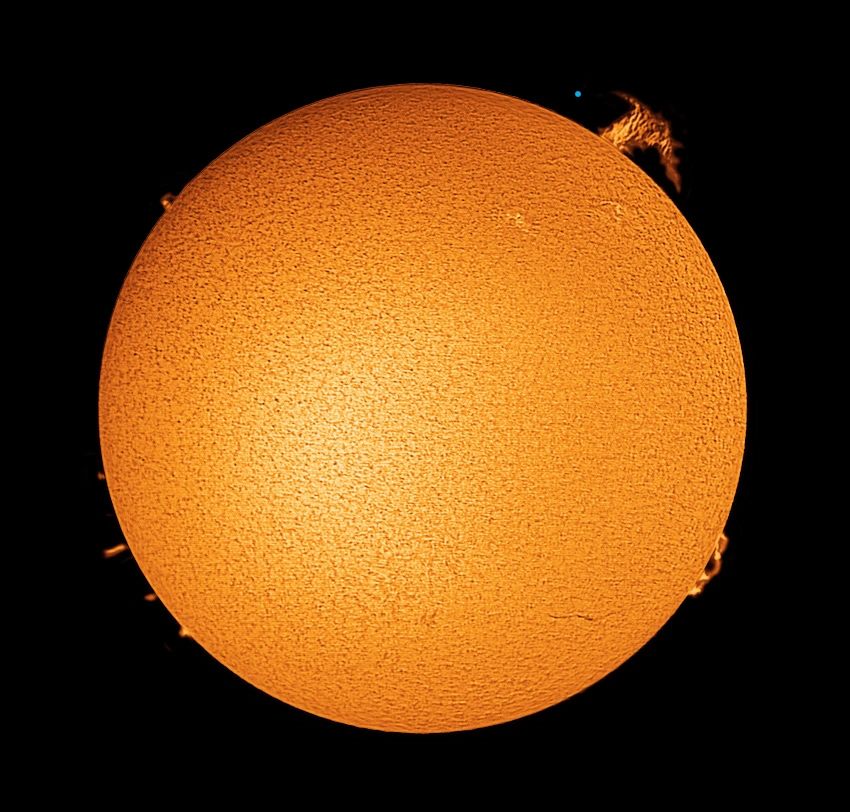
Important Note!
Looking at the Sun can be dangerous and lead to blindness! Be sure to use only approved solar filters to view or image the Sun.
solar imaging
Introduction
The images you will be viewing were made using Coronado PST hydrogen-alpha solar telescope. This is a 40mm (1.6”) telescope that views only the red spectral line associated with hydrogen dropping from the third to second lowest energy level. As a result, all light is blocked except the tiny fraction of red that is from hydrogen-alpha (in this case more than 99.97% of the light is blocked) - this makes it safe to view the Sun. Since most color cameras have RGGB (red, green, green, blue) filters on their sensors, I would be wasting 3 out of 4 of the pixels; I therefore take B&W images so that I can use all pixels. To capture each image, I use a photographic technique called focus stacking where I take many images (500 in this case) and use those to create one really good quality image. Since focus, sky clarity, humidity, etc. change over very short periods of time (just look through a telescope for a few minutes to prove this to yourself), this process helps corrects for those imperfections. The focus stacking program searches each image for ‘in-focus’ areas and places those areas in the final image – creating a final image that is as sharp and clear as possible. On this scope you also have to 'tune' a special filter (called an etalon) to get the right frequency of red to show each feature at its best and, as a result, separate imaging is required to capture features such as sunspots, plages, filaments, prominences and flares. I must then combine these into a composite image using Photoshop. I finish by adding color and a ‘blue dot’ to represent the size of the Earth and then save as a smaller file to share.
Important Words: Image showing these features follow:
Plage (Pl) - bright active region
Sunspot (ss)– cooler regions on the Sun caused by magnetic field interactions
De-Tuned Sunspot (dt)– The H-a telescope can be de-tuned to simulate a ‘white light’ solar telescope and show sunspots with umbral and penumbral features
Umbra – dark, inner region of a sunspot
Penumbra – outer, lighter region of a sunspot
Prominence (P) - plasma/hot gas arcs that follow magnetic field lines
Filament (F) - dark arcs - these are prominences seen from above and so appear cooler
Flare – a brief, high-energy eruption on the Sun associated with sunspots
Spicules (S) – jets of gas/plasma ejected from the Sun seen on the limb of the Sun
Barlow lens – lens used to increase the magnification of an image – mine is 2x
Introductory Explanation Images
Jon with the small H-a telescope (gold on left) with digital camera attached (red on telescope). The mount has a tracking camera so it follows the Sun. The laptop is in the cardboard box to block light so I can see the images.
Favorite Solar IMages
October 22, 2020
Favorite Solar Videos
Large Prominence from March 30, 2021
This is my favorite video clip so far. Large prominence over 45 minutes created from 90 images - processed, cropped, aligned, colorized, made into a GIF and converted to video for this website. Sorry, I can't figure out how to loop the clip in this website...
Prominence from July 31, 2020
Video clip made from 10 images over about 5 minutes. As you can see, the Sun can be quite active!
Prominences from September 6, 2020
Video clip made from 80 images over about 45 minutes. Check out the small prominences erupting and disappearing on left.
Favorite Solar Videos
Flare capture from May 11, 2022 - first time for me!
I wanted to share a series of 35 solar images (roughly 30 minutes of imaging) I made into an AVI. I was finally lucky enough to capture a flare erupting near the end of the video on the left side. I didn't see it in my scope until I processed the images so missed being able to capture the entire event. Please try running it several times to see the details. Enjoy!
Copyright © 2024 Science Guy, Maine - All Rights Reserved.
Powered by GoDaddy
This website uses cookies.
We use cookies to analyze website traffic and optimize your website experience. By accepting our use of cookies, your data will be aggregated with all other user data.